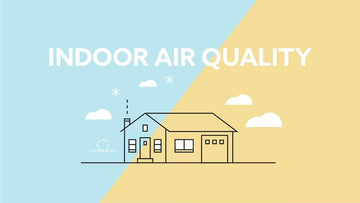The Global Challenge of Indoor Air Quality: Data and Solutions
Indoor air quality (IAQ) is a critical health issue that often goes unnoticed. As we spend a significant portion of our time indoors, the quality of the air we breathe in our homes, offices, and schools directly impacts our health and well-being. Various pollutants, including allergens, chemicals, volatile organic compounds (VOCs), dander, and particulate matter (PM 2.5), contribute to poor IAQ. This article delves into the available data on indoor air quality issues in the United States, Europe, and Canada and explores how companies like IQ Air and other air purification systems have grown in response to these challenges.
Indoor Air Quality Issues: A Data-Driven Overview
United States
- Pollutants and Health Impact: According to the Environmental Protection Agency (EPA), indoor air pollutants can be two to five times higher than outdoor levels. The EPA identifies common indoor pollutants such as radon, tobacco smoke, VOCs, mold, and PM 2.5. Poor IAQ is linked to respiratory illnesses, cardiovascular diseases, and even cancer.
- Allergies and Asthma: The Asthma and Allergy Foundation of America reports that over 25 million Americans have asthma, and around 50 million suffer from allergies each year. Indoor allergens such as dust mites, pet dander, and mold are significant triggers.
- PM 2.5 Pollution: PM 2.5 refers to fine particulate matter with a diameter of 2.5 micrometers or smaller. These particles can penetrate deep into the lungs and even enter the bloodstream. The American Lung Association highlights that indoor PM 2.5 levels are often elevated due to cooking, smoking, and the use of candles.
Europe
- Pollutants and Health Impact: The European Environment Agency (EEA) states that indoor air pollution is a significant health risk in Europe, with pollutants such as formaldehyde, benzene, and nitrogen dioxide commonly found indoors. These pollutants can cause various health issues, from respiratory problems to neurological effects.
- Allergies and Asthma: According to the European Federation of Allergy and Airways Diseases Patients’ Associations (EFA), around 150 million Europeans suffer from chronic allergic diseases. Indoor allergens are a leading cause of these conditions.
- PM 2.5 Pollution: The EEA reports that PM 2.5 is a major concern in European homes, with sources including cooking, heating, and outdoor air infiltration. High levels of PM 2.5 are linked to serious health problems, including heart disease and lung cancer.
Canada
- Pollutants and Health Impact: Health Canada notes that Canadians spend approximately 90% of their time indoors, where air quality can be significantly worse than outdoors. Common indoor pollutants include VOCs, carbon monoxide, and PM 2.5.
- Allergies and Asthma: The Canadian Allergy, Asthma, and Immunology Foundation (CAAIF) reports that about 30% of Canadians are affected by allergies, with indoor allergens like mold, pet dander, and dust mites being primary triggers.
- PM 2.5 Pollution: Environment Canada highlights that indoor sources of PM 2.5 include tobacco smoke, cooking, and the use of wood-burning appliances. High indoor PM 2.5 levels contribute to respiratory and cardiovascular diseases.
Rising Demand for Air Purification Systems
Given the increasing awareness of indoor air quality issues and the associated health risks, there has been a significant rise in demand for air purification systems worldwide. Companies like IQ Air have experienced substantial growth and popularity as they offer solutions to mitigate these challenges.
Growth in Air Purification Market
- Market Trends: The global air purifier market is projected to grow from $9.55 billion in 2021 to $16.32 billion by 2028, at a compound annual growth rate (CAGR) of 7.8%. This growth is driven by heightened awareness of air quality issues and the need for clean indoor air.
- Technological Advancements: Companies like IQ Air have developed advanced air purification technologies that effectively remove a wide range of pollutants, including PM 2.5, VOCs, and allergens. HEPA filters, activated carbon filters, and UV-C light are among the technologies used to enhance air purification efficiency.
- Consumer Demand: The COVID-19 pandemic has further increased the demand for air purifiers, as people seek to improve indoor air quality to reduce the risk of airborne infections. A survey by the American Society of Heating, Refrigerating and Air-Conditioning Engineers (ASHRAE) found that 80% of respondents consider air purifiers an essential part of their indoor air quality strategy.
IQ Air and Industry Leaders
- IQ Air: IQ Air is a leading player in the air purification market, known for its high-performance air purifiers that can capture ultra-fine particles and gases. Their products are used in homes, hospitals, schools, and offices worldwide.
- Other Industry Leaders: Brands like Dyson, Honeywell, and Blueair have also seen increased demand for their air purification products. These companies offer a range of solutions, from portable air purifiers to integrated HVAC systems designed to improve indoor air quality.
Indoor air quality is a pressing issue that affects millions of people across the United States, Europe, and Canada. The presence of pollutants, allergens, chemicals, VOCs, dander, and PM 2.5 poses significant health risks, making it essential to address these challenges proactively. The growing awareness of indoor air pollution and its health impacts has led to a surge in demand for air purification systems. Companies like IQ Air and other industry leaders are at the forefront of providing effective solutions to ensure cleaner, healthier indoor air. Investing in advanced air purification technologies is not just a trend but a crucial step towards safeguarding our health and well-being in an increasingly polluted world.






